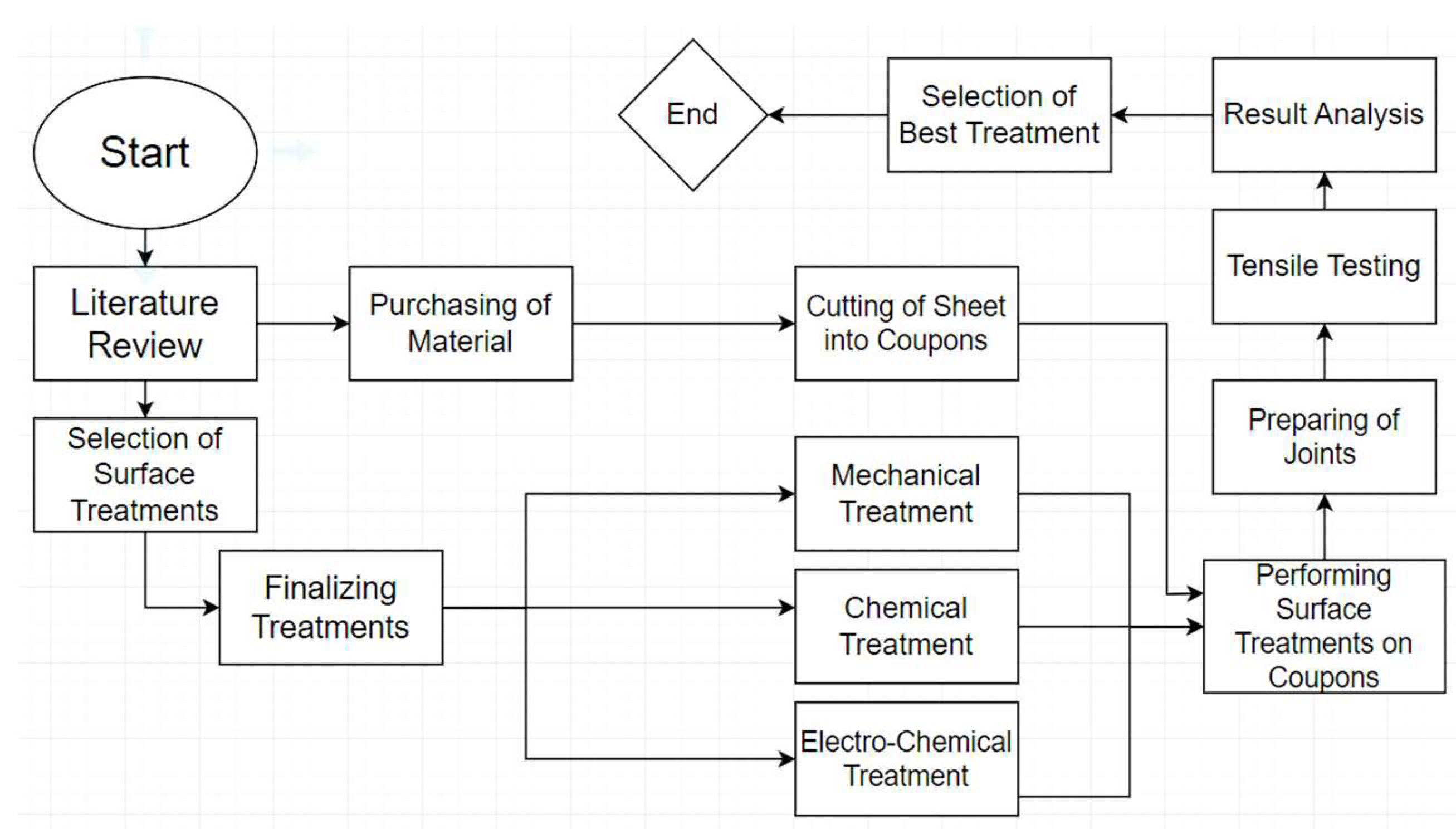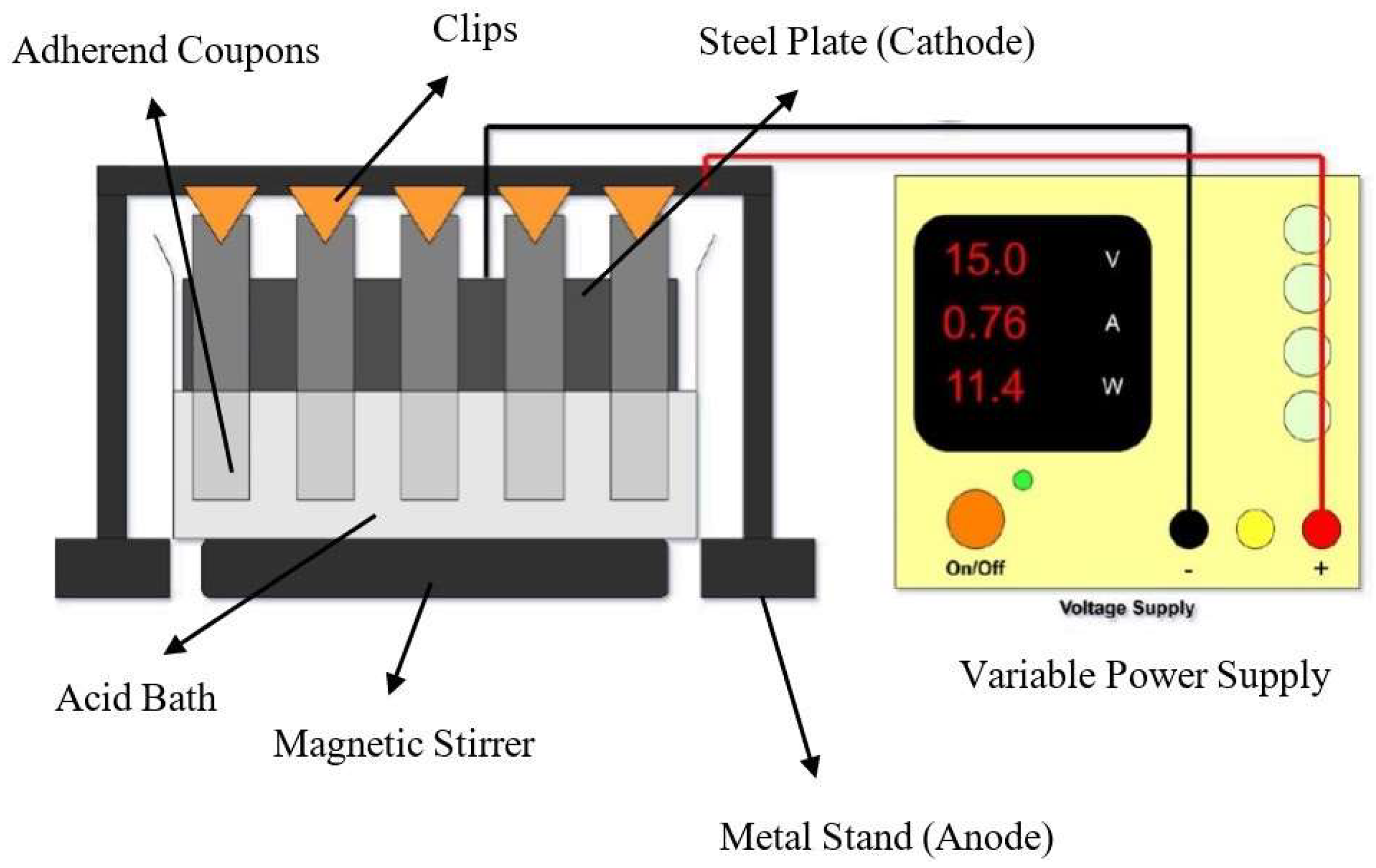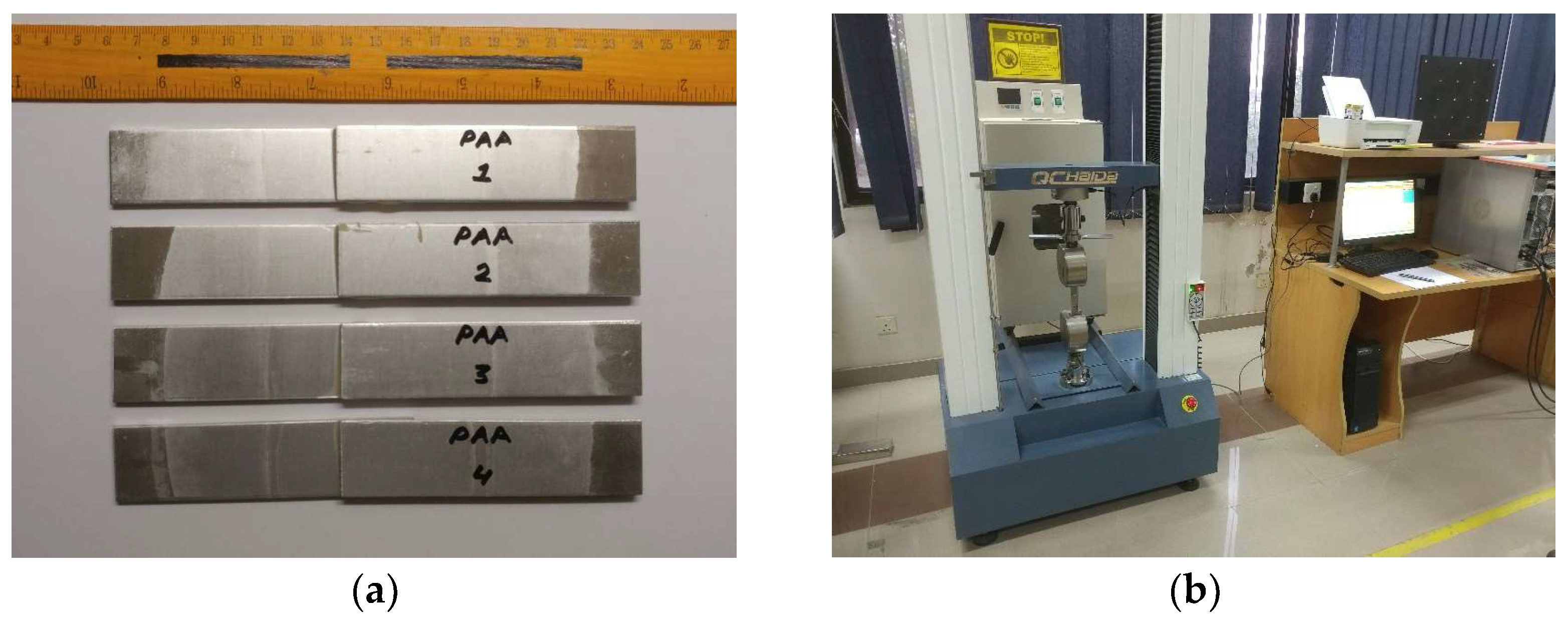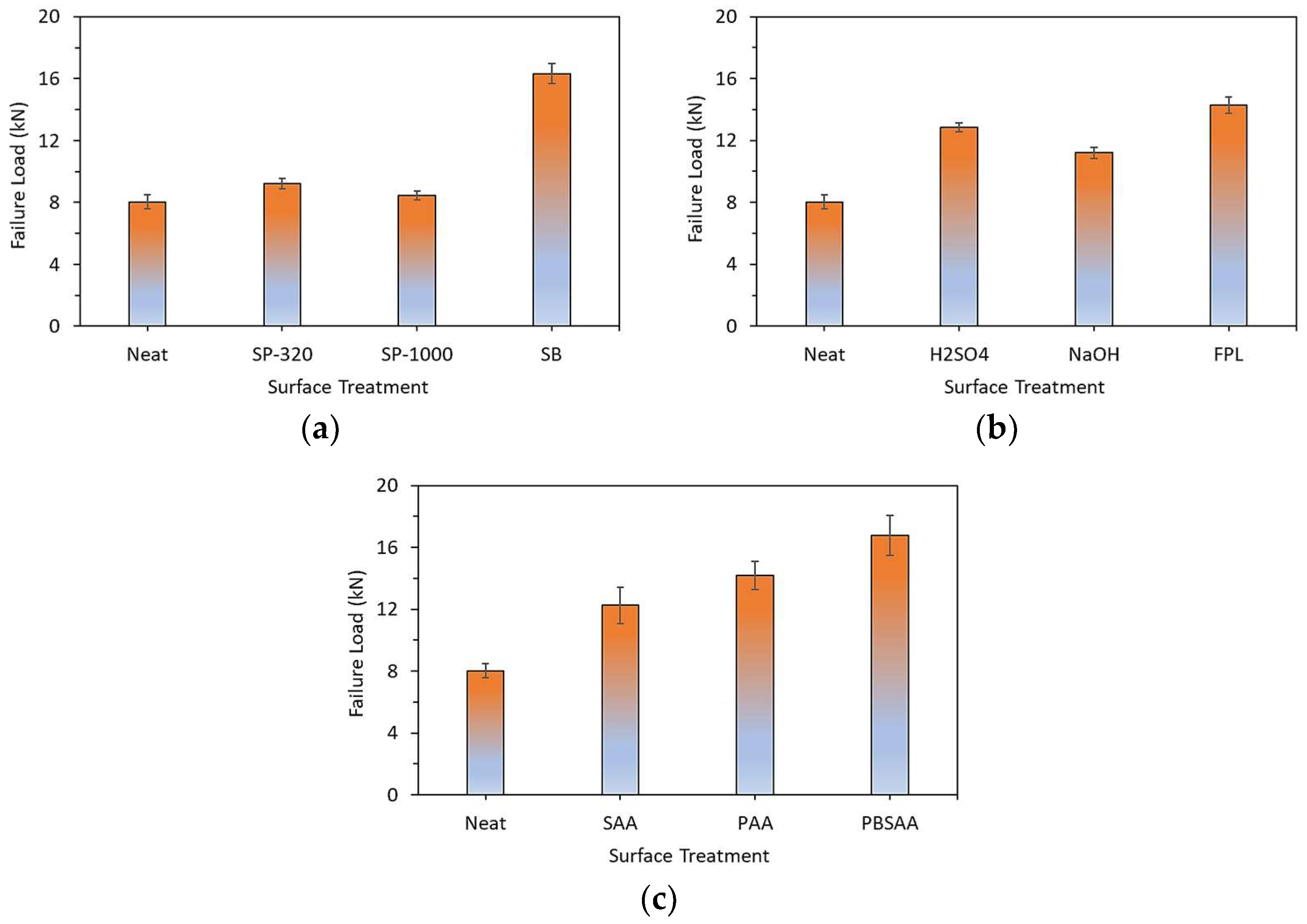Surface Treatment Strategies to Enhance Adhesive Bond Strength for AA7075-T6 in Aerospace Applications †
Abstract
:1. Introduction
2. Materials and Methods
2.1. Materials
2.2. Methodology
2.3. Surface Treatment Performed
- Mechanical Treatment: This method utilizes techniques like sandblasting and sanding to physically abrade the surface layer.
- Chemical Treatment: This approach employs alkaline or acidic etching solutions to dissolve the oxide layer and etch the surface.
- Electrochemical Treatment: The process in which an oxide layer is deposited on the aluminum surface, enhancing corrosion resistance and potentially improving bond strength.
- Neat Coupons (Solvent Degreasing): A through degreasing step on the coupons were performed using solvents. In which first the area to be treated was wiped with toluene solution with a soft cloth. Subsequently, the coupons were immersed in a bath of pure acetone for 20 min to ensure complete removal of residual contaminants. These coupons were used to make a neat joint configuration for the control case.
- Mechanical Treatment: This method employed two techniques: sandpaper abrasion and sandblasting. Sandpaper with grits of 320 and 1000 was used for mechanical etching. Through the use of a portable device, high-velocity sand particles were used in to abrade the surface. Solvent degreasing as done for the neat coupons was performed after each treatment.
- Chemical Treatment: Chemical etching utilizes an etchant solution to react with the metal surface to create a roughened profile. This study investigated both alkaline and acidic etchants, with specific details on concentration, time, temperature, and solution type are provided in Table 1. The process involved solvent degreasing, followed by immersion in the etchant solution at elevated temperatures (55–65 °C) for 10–15 min. For NaOH etching a subsequent de-smutting step in HNO3 bath was required to remove the black layer formed by the chemical reaction. A final rinse with distilled water and subsequently drying completed the treatment. For An illustration of the etching process is shown in Figure 3.
- Electrochemical Treatment (Anodization): This process aims to create a controlled, porous oxide layer on the aluminum surface to enhance surface roughness. Figure 4 shows a schematic of the procedure used for anodization. Similar to chemical treatment, the process began with the solvent degreasing step. This was followed by etching with a NaOH solution for 4 min at 50 °C, and a subsequent de-smutting step using an HNO3 bath for 3 min. Rinsing with distilled water was performed between each step to prevent solution contamination. Anodization was performed in an acid bath with steel as the cathode, at 15 V for 25–30 min. The bath temperature was kept between 26 and 29 °C to complete the anodization process. The coupons were then completely cleaned with distilled water until a neutral pH of 7 was attained. Specific details regarding types of anodization performed and their respective concentration, time, and temperature parameters are provided in Table 2.
2.4. Lap Joints Fabrication and Testing
3. Results and Discussion
3.1. Mechanical Surface Treatment
3.2. Chemical Surface Treatment
3.3. Electro-Chemical Surface Treatment
3.4. Discussion
4. Conclusions
Author Contributions
Funding
Institutional Review Board Statement
Informed Consent Statement
Data Availability Statement
Conflicts of Interest
References
- Real, J.D.; De Santayana, M.C.; Abenojar, J.; Martinez, M. Adhesive bonding of aluminium with structural acrylic adhesives: Durability in wet environments. J. Adhes. Sci. Technol. 2006, 20, 1801–1818. [Google Scholar] [CrossRef]
- Campbell, F. Introduction to composite materials. Struct. Compos. Mater. 2010, 1, 1–29. [Google Scholar]
- Burkholder, G.L.; Kwon, Y.W.; Pollak, R.D. Effect of carbon nanotube reinforcement on fracture strength of composite adhesive joints. J. Mater. Sci. 2011, 46, 3370–3377. [Google Scholar] [CrossRef]
- Kweon, J.-H.; Jung, J.-W.; Kim, T.-H.; Choi, J.-H.; Kim, D.-H. Failure of carbon composite-to-aluminum joints with combined mechanical fastening and adhesive bonding. Compos. Struct. 2006, 75, 192–198. [Google Scholar] [CrossRef]
- Ejaz, H.; Mubashar, A.; Uddin, E.; Ali, Z.; Arif, N. Effect of functionalised and non-functionalised GNPs addition on strength properties of high viscous epoxy adhesive and lap shear joints. Polym. Test. 2022, 113, 107680. [Google Scholar] [CrossRef]
- Banea, M.D.; da Silva, L.F.M. Adhesively bonded joints in composite materials: An overview. Proc. Inst. Mech. Eng. Part L J. 2009, 223, 1–18. [Google Scholar] [CrossRef]
- Adams, R.D.; Adams, R.D.; Comyn, J.; Wake, W.C.; Wake, W. Structural Adhesive Joints in Engineering; Springer Science & Business Media: Berlin, Germany, 1997. [Google Scholar]
- Ejaz, H.; Mubashar, A.; Uddin, E.; Ali, Z.; Arif, N. Influence of MWCNTs on Strength Properties of High Viscous Epoxy Adhesive and Fracture Behavior of Adhesively Bonded Joints. Theor. Appl. Fract. Mech. 2022, 120, 103412. [Google Scholar] [CrossRef]
- Dixon, D. Aerospace applications of adhesives. In Handbook of Adhesion; Wiley: Hoboken, NJ, USA, 2005; pp. 40–42. [Google Scholar]
- Watson, C. Engineering design with adhesives. In Handbook of Adhesion; Wiley: Hoboken, NJ, USA, 2005; p. 138. [Google Scholar]
- Correia, S.; Anes, V.; Reis, L. Effect of surface treatment on adhesively bonded aluminium-aluminium joints regarding aeronautical structures. Eng. Fail. Anal. 2018, 84, 34–45. [Google Scholar] [CrossRef]
- Guo, L.; Liu, J.; Xia, H.; Li, X.; Zhang, X.; Yang, H. Effects of surface treatment and adhesive thickness on the shear strength of precision bonded joints. Polym. Test. 2021, 94, 107063. [Google Scholar] [CrossRef]
- Critchlow, G.; Brewis, D. Review of surface pretreatments for aluminium alloys. Int. J. Adhes. Adhes. 1996, 16, 255–275. [Google Scholar] [CrossRef]
- Saleema, N.; Sarkar, D.K.; Paynter, R.W.; Gallant, D.; Eskandarian, M. A simple surface treatment and characterization of AA 6061 aluminum alloy surface for adhesive bonding applications. Appl. Surf. Sci. 2012, 261, 742–748. [Google Scholar] [CrossRef]
- Abid, J.; Raza, H.; Akhtar, A.; Gohar, G.A.; Ullah, S.; Akram, M.; Raza, Y.; Bukhari, M.D. Effect of surface roughness on shear strength of bonded joints of aluminum Al 6061 T6 substrate. VW Appl. Sci. 2020, 2, 87–91. [Google Scholar] [CrossRef]
- Ghumatkar, A.; Budhe, S.; Sekhar, R.; Banea, M.; Barros, S.d. Influence of adherend surface roughness on the adhesive bond strength. Lat. Am. J. Solids Struct. 2016, 13, 2356–2370. [Google Scholar] [CrossRef]
- Ejaz, H.; Saboor, D.; Sohail, M.S.B.; Mansoor, A.H. Effect of various surface treatments on lap shear strength of aluminum adhesive joints. In Proceedings of the 2022 19th International Bhurban Conference on Applied Sciences and Technology (IBCAST), Islamabad, Pakistan, 16–20 August 2022; pp. 76–81. [Google Scholar]
- ASTM D1002-10; Standard Test Method for Apparent Shear Strength of Single-lap-joint Adhesively Bonded Metal Specimens by Tension Loading (Metal-to-Metal). ASTM International: West Conshohocken, PA, USA, 2020.







| Solution | Time (min.) | Concentration (Wt.%) | Temperature (°C) |
|---|---|---|---|
| NaOH | 10 | 6 | 55–60 |
| H2SO4 | 15 | 10 | 60–65 |
| Dichromate/Sulfuric (FPL) | 15 | 6/26.7 | 60–65 |
| Solution | Time (min.) | Concentration (Wt.%) | Temperature (°C) |
|---|---|---|---|
| H2SO4 | 25–30 | 6 | 26–29 |
| H3PO4 | 25–30 | 20 | 26–29 |
| H3PO4/H3BO3/H2SO4 | 25–30 | 5/0.8/5 | 26–29 |
| Mechanical Treatment | Strength (MPa) | Standard Deviation | Improvement (%) |
|---|---|---|---|
| Neat | 12.63 | 0.70 | - |
| SP-320 | 14.50 | 0.51 | 14.78 |
| SP-1000 | 13.29 | 0.46 | 5.21 |
| Sand Blasted | 25.70 | 1.07 | 103.35 |
| Chemical Treatment | Strength (MPa) | Standard Deviation | Improvement (%) |
|---|---|---|---|
| NaOH | 17.63 | 0.56 | 39.51 |
| H2SO4 | 20.23 | 0.47 | 60.12 |
| Dichromate/Sulfuric (FPL) | 22.48 | 0.81 | 77.90 |
| Electro-Chemical Treatment | Strength (MPa) | Standard Deviation | Improvement (%) |
|---|---|---|---|
| H2SO4 (SAA) | 19.28 | 1.83 | 52.61 |
| H3PO4 (PAA) | 22.31 | 1.42 | 76.55 |
| H3PO4/H3BO3/H2SO4 (PBSAA) | 26.40 | 2.2 | 109 |
Disclaimer/Publisher’s Note: The statements, opinions and data contained in all publications are solely those of the individual author(s) and contributor(s) and not of MDPI and/or the editor(s). MDPI and/or the editor(s) disclaim responsibility for any injury to people or property resulting from any ideas, methods, instructions or products referred to in the content. |
© 2024 by the authors. Licensee MDPI, Basel, Switzerland. This article is an open access article distributed under the terms and conditions of the Creative Commons Attribution (CC BY) license (https://creativecommons.org/licenses/by/4.0/).
Share and Cite
Ejaz, H.; Wahab, A.; Saeed, R.; Ahmed, A.; Masud, M. Surface Treatment Strategies to Enhance Adhesive Bond Strength for AA7075-T6 in Aerospace Applications. Eng. Proc. 2024, 75, 37. https://doi.org/10.3390/engproc2024075037
Ejaz H, Wahab A, Saeed R, Ahmed A, Masud M. Surface Treatment Strategies to Enhance Adhesive Bond Strength for AA7075-T6 in Aerospace Applications. Engineering Proceedings. 2024; 75(1):37. https://doi.org/10.3390/engproc2024075037
Chicago/Turabian StyleEjaz, Hassan, Abdul Wahab, Romail Saeed, Ammad Ahmed, and Manzar Masud. 2024. "Surface Treatment Strategies to Enhance Adhesive Bond Strength for AA7075-T6 in Aerospace Applications" Engineering Proceedings 75, no. 1: 37. https://doi.org/10.3390/engproc2024075037
APA StyleEjaz, H., Wahab, A., Saeed, R., Ahmed, A., & Masud, M. (2024). Surface Treatment Strategies to Enhance Adhesive Bond Strength for AA7075-T6 in Aerospace Applications. Engineering Proceedings, 75(1), 37. https://doi.org/10.3390/engproc2024075037






